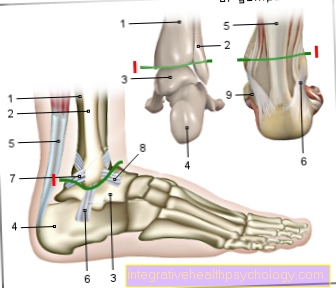Anesthesia for a colonoscopy- is it dangerous?
General
A colonoscopy is an examination procedure in which you can view the intestinal mucosa with the help of a special tool, the endoscope.
The endoscope is a flexible tube at the end of which there is a camera. This camera then transmits images of the intestinal mucosa on a screen, which the doctor can see.

The colonoscopy is, on the one hand, a diagnostic procedure with which changes in the intestinal mucosa, such as inflammation, ulcers, or bleeding, can be detected at an early stage, in some cases even before the person affected becomes ill.
On the other hand, it is also a therapeutic procedure, because in the context of a colonoscopy, tumors (the so-called polyps), Bulges (the so-called diverticula) or precursors of colon cancer can be removed.
A colonoscopy can be done in a practice (outpatient) or in the hospital (stationary) respectively.
In principle, the colonoscopy is a less painful procedure. However, when the endoscope is advanced, pulling or pressure on the intestine can cause pain.
Please also read our page The course of a colonoscopy.
A colonoscopy can therefore be carried out if necessary using various medications. On the one hand, sedatives such as benzodiazepines are available. Midazolam is an important representative of this group.
These cause the patient to sleep during the examination and thus not even notice the examination and the potential pain.
However, since some patients stay awake and also want to look at the screen on which the images of the intestinal mucosa are being transmitted, there is also the option of injecting painkillers only when pain occurs. This is usually an opioid, such as tramadol.
Another option is to have the colonoscopy under short anesthesia. Anesthesia is generally understood to mean the temporary loss of consciousness. With a short anesthetic, this state of unconsciousness is only maintained for a short time. Often times, the condition is brought about with a drug called propofol.
In the case of short anesthesia with propofol, a syringe pump is applied through an access in a patient's vein. The syringe pump ensures that propofol continuously enters the patient's circulation during the procedure, thus maintaining the short-term anesthesia for the duration of the colonoscopy. Propofol starts to work after a minute.
Read more on the subject at: Types of anesthesia - which are there?
Is anesthesia dangerous for a colonoscopy?
Side effects and risks of a colonoscopy
In general, complications with endoscopic procedures, such as the colonoscopy, are very rare these days. Overall, short anesthesia is not considered dangerous for a colonoscopy.
The colonoscopy under short anesthesia with propofol is usually well tolerated and has several advantages. A colonoscopy under short anesthesia is much more comfortable and less traumatic, especially for very anxious and pain-sensitive patients.
The short anesthesia also harbors Risksthat must be considered in any patient who needs a colonoscopy.
About half of all side effects that occur during a colonoscopy are caused by the short anesthesia.
Possible side effects during / after a short anesthetic with Propofol:
- dizziness
- Restlessness
- nausea
- Vomit
- "Bad Trips" (bad dreams that seem very real)
- Memory gaps (amnesia)
- Breathing disorders
- Drop in blood pressure
- Cardiac arrhythmias
The mentioned Disturbances in the cardiovascular system and breathing particularly affect older patients and patients with comorbidities such as high blood pressure or heart failure, which is why particular caution should be exercised in this group of patients.
At Pregnant women and children under 16 years Propofol should not be used for short anesthesia at all. Furthermore, some patients may have an allergic reaction to propofol. In the worst case, it can even lead to an allergic shock.
Another possible side effect of propofol is that Propofol infusion syndrome occurs. Propofol Infusion Syndrome is an extremely rare complication in which heart failure, too Cardiac arrhythmias, to acute kidney failure, hyperacidity of the Blood and the muscles dissolve. Propofol infusion syndrome is a life-threatening complication and must be treated immediately and is therefore very dangerous for those affected.
Most important is that Stop the propofol administration and the Supply of fluids and medicationthat maintain the patient's circulation. Due to the risks mentioned, all patients are continuously monitored with the help of monitors during the procedure, so changes such as cardiac arrhythmias, a drop in blood pressure or oxygen saturation can be noticed at an early stage and countermeasures can be initiated in good time.
The procedure itself also involves risks, both with and without short anesthesia. So it can be as part of a colonoscopy too Injuries to the intestinal mucosa or to Perforations in the intestinal wall (Piercing the intestinal wall) come. If there is a perforation of the intestinal wall Bacteria from the intestines get into the abdominal cavity and Infections cause. If the bacteria get into the bloodstream there is a risk of developing one sepsis (Blood poisoning). In the case of sepsis, among other things, a Antibiotic therapy and intensive medical monitoring necessary. Bleeding is also a possible side effect of a colonoscopy.
Please also read our page Side effects and risks of anesthesia.
Benefits with anesthesia
One advantage of having a colonoscopy under anesthesia is that you will not notice anything of the relatively unpleasant examination. A colonoscopy can definitely cause discomfort and sometimes pain. For example, air is blown into the intestine so that the intestinal wall unfolds. This can be perceived as an uncomfortable feeling. In addition, moving the endoscope can cause pain in the patient.
Since this is also a short anesthetic, which puts the patient into a deep sleep, the side effects are relatively minor and complications are very rare. In addition, many patients report that falling asleep and waking up while taking propofol are perceived as pleasant. Finally, there is another advantage that benefits both the examiner and the patient: the sedation makes the patient relaxed and not cramped. This makes the colonoscopy with anesthesia easier for the doctor to perform and it is over faster for the patient.
Disadvantages with anesthesia
Patients who have received anesthesia are allowed for legal reasons for Do not actively participate in public transport for 24 hours. Furthermore, patients may still feel a bit drowsy after the anesthesia. This feeling can be felt throughout the day and therefore also mental activities influence and limit. In addition, the patient must be anesthetized by a colonoscopy Accompanying person to be picked upwhich is not necessary without anesthesia.
Furthermore - although the sedation is only very light and relatively few side effects - are nevertheless Possible risks. Propofol lowers that Heart work and slows them down breathing. If the dose is too high, it can lead to cardiac arrest. By reducing breathing, the level of oxygen in the blood can drop and cause a Oxygen supply make necessary. In the worst and very rare cases, breathing stops. Cardiac and respiratory arrest would mean that artificial respiration and resuscitation would have to be given. However, these complications are very, very rare.
Can you drive a car with anesthesia after a colonoscopy?
In almost all cases, anesthesia for a colonoscopy is carried out using propofol. Although this is a narcotic (= Anesthetic) with a short duration of action, which puts the patient into a deep sleep, it can still be after waking up Limitations in responsiveness come. These restrictions can still 24 hours after the dose occur. Patients should therefore be picked up by an accompanying person and should not drive a car or otherwise actively participate in public transport until the next day.
Cost of anesthesia
For patients with statutory health insurance, a colonoscopy is free of charge from the age of 55. Another colonoscopy after another 10 years is also paid for by the statutory health insurance. If a patient has an increased risk of colon cancer, for example due to a family history, or if a patient has symptoms that could be explained by an intestinal disease, the statutory health insurance will pay for a colonoscopy before the age of 55.
If the patient requires a short anesthetic, or medication to calm or relieve pain, there are no additional costs for him.
Read more on the topic: Cost of a colonoscopy
Duration of anesthesia
The duration of the colonoscopy depends on various factors.
For one thing, it plays Texture of the intestine an important role. For example, with a strongly curved bowel, visibility can be poor and the duration of the colonoscopy can be extended. Furthermore, a colonoscopy takes longer if the examination shows pathological changes such as bleeding or Lumps (Polyps) are found as if it was a healthy intestinal lining. Because of these factors, the duration of a colonoscopy usually varies between 15 and 30 minutes. If the patient wants a short anesthetic, this is maintained for the same period.
You can find much more extensive information under our topic: Duration of a colonoscopy




















.jpg)








